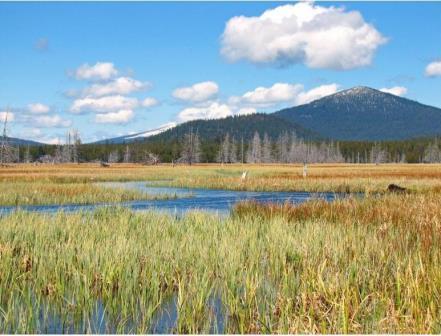A Unique, High Altitude Wetland
Big Marsh is shrouded in a certain stillness; despite the wind combing through the sedge, and the slight lap of water; despite the constant pulse of singing insects, and the occasional hush of a heron’s wings, these wetlands feel heavy with ancient, inviting stillness. You can sense the rareness of this landscape.
 At 2,000 acres and 4,700 ft. elevation, Big Marsh is one of the largest high-altitude wetlands in the continental United States. This lush setting serves as a gathering place where wildlife can nest, hunt, and, most importantly, find clean, unpolluted water. Its unique, high-elevation location makes Big Marsh an ideal refuge from the consequences of climate change. As the lowlands become drier and hotter, and wildlife migrates to cooler altitudes, pristine high-elevation water sources like Big Marsh will become even more important.
At 2,000 acres and 4,700 ft. elevation, Big Marsh is one of the largest high-altitude wetlands in the continental United States. This lush setting serves as a gathering place where wildlife can nest, hunt, and, most importantly, find clean, unpolluted water. Its unique, high-elevation location makes Big Marsh an ideal refuge from the consequences of climate change. As the lowlands become drier and hotter, and wildlife migrates to cooler altitudes, pristine high-elevation water sources like Big Marsh will become even more important.
Today, Big Marsh is already a vital habitat for many sensitive bird species, including the northern spotted owl, the great gray owl, the yellow rail, the northern goshawk, and the sandhill crane. Big Marsh is also home to the largest known population of the Oregon Spotted Frog, which is listed as threatened under the Endangered Species Act. Loss of marsh habitat is one of the major forces behind the frogs’ decline; nearly their entire historic habitat in the Willamette and Klamath basins has been eradicated due to dams, development, the introduction of exotic species, and livestock overgrazing. The protection of remaining wetlands like Big Marsh is absolutely critical to the Oregon Spotted Frogs’ survival.
Big Marsh is currently included in the Oregon Conservation Recreation Area. This means that potentially destructive activities like off-highway vehicle use, road-building, and logging are permitted, and Big Marsh is at risk. That’s why Oregon Wild has included this area in the Crater Lake Wilderness Proposal—to preserve this ecosystem for wildlife and humans alike.
Big Marsh is a great place to hike, or backpack, or bird-watch. It’s located in the Deschutes National Forest, about three hours southeast of Portland and an hour north of Crater Lake National Park. To get to Big Marsh, take Highway 58 and turn left onto Forest-Service Road 5825. Follow this road to the trailhead. There, you’ll find trails and footbridges that cross over creeks, through pine forests and meadows, and along the perimeter of the wetlands, providing expansive views of the sun-warmed marshland and the hills that border it. There’s no better place to take in the blending of light in the late afternoon; all the blues, and the greens, and the fading yellows; all the colors of the water just beginning to drift away, everything wrapped up in that remarkable stillness.

